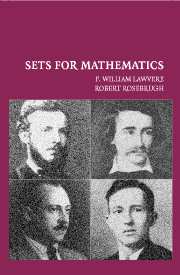Book contents
- Frontmatter
- Contents
- Foreword
- Contributors to Sets for Mathematics
- 1 Abstract Sets and Mappings
- 2 Sums, Monomorphisms, and Parts
- 3 Finite Inverse Limits
- 4 Colimits, Epimorphisms, and the Axiom of Choice
- 5 Mapping Sets and Exponentials
- 6 Summary of the Axioms and an Example of Variable Sets
- 7 Consequences and Uses of Exponentials
- 8 More on Power Sets
- 9 Introduction to Variable Sets
- 10 Models of Additional Variation
- Appendixes
- A Logic as the Algebra of Parts
- B The Axiom of Choice and Maximal Principles
- C Definitions, Symbols, and the Greek Alphabet
- Bibliography
- Index
A - Logic as the Algebra of Parts
Published online by Cambridge University Press: 06 July 2010
- Frontmatter
- Contents
- Foreword
- Contributors to Sets for Mathematics
- 1 Abstract Sets and Mappings
- 2 Sums, Monomorphisms, and Parts
- 3 Finite Inverse Limits
- 4 Colimits, Epimorphisms, and the Axiom of Choice
- 5 Mapping Sets and Exponentials
- 6 Summary of the Axioms and an Example of Variable Sets
- 7 Consequences and Uses of Exponentials
- 8 More on Power Sets
- 9 Introduction to Variable Sets
- 10 Models of Additional Variation
- Appendixes
- A Logic as the Algebra of Parts
- B The Axiom of Choice and Maximal Principles
- C Definitions, Symbols, and the Greek Alphabet
- Bibliography
- Index
Summary
Why Study Logic?
The term “logic” has always had two meanings – a broader one and a narrower one:
(1) All the general laws about the movement of human thinking should ultimately be made explicit so that thinking can be a reliable instrument, but
(2) already Aristotle realized that one must start on that vast program with a more sharply defined subcase.
The achievements of this subprogram include the recognition of the necessity of making explicit
(a) a limited universe of discourse, as well as
(b) the correspondence assigning, to each adjective that is meaningful over a whole universe, the part of that universe where the adjective applies. This correspondence necessarily involves
(c) an attendant homomorphic relation between connectives (like and and or) that apply to the adjectives and corresponding operations (like intersection and union) that apply to the parts “named” by the adjectives.
When thinking is temporarily limited to only one universe, the universe as such need not be mentioned; however, thinking actually involves relationships between several universes. For example, the three universes (1) of differential equations, (2) of functions of time, and (3) of formal power series are all distinct with different classes of adjectives meaningful over each one. But there are key relationships between these three universes that are the everyday preoccupation of users of many mathematical sciences: a function might satisfy a differential equation, a power series might approximate a function or might formally satisfy a differential equation, whereas we might seek to solve a differential equation or expand a function, and so on.
- Type
- Chapter
- Information
- Sets for Mathematics , pp. 193 - 219Publisher: Cambridge University PressPrint publication year: 2003



